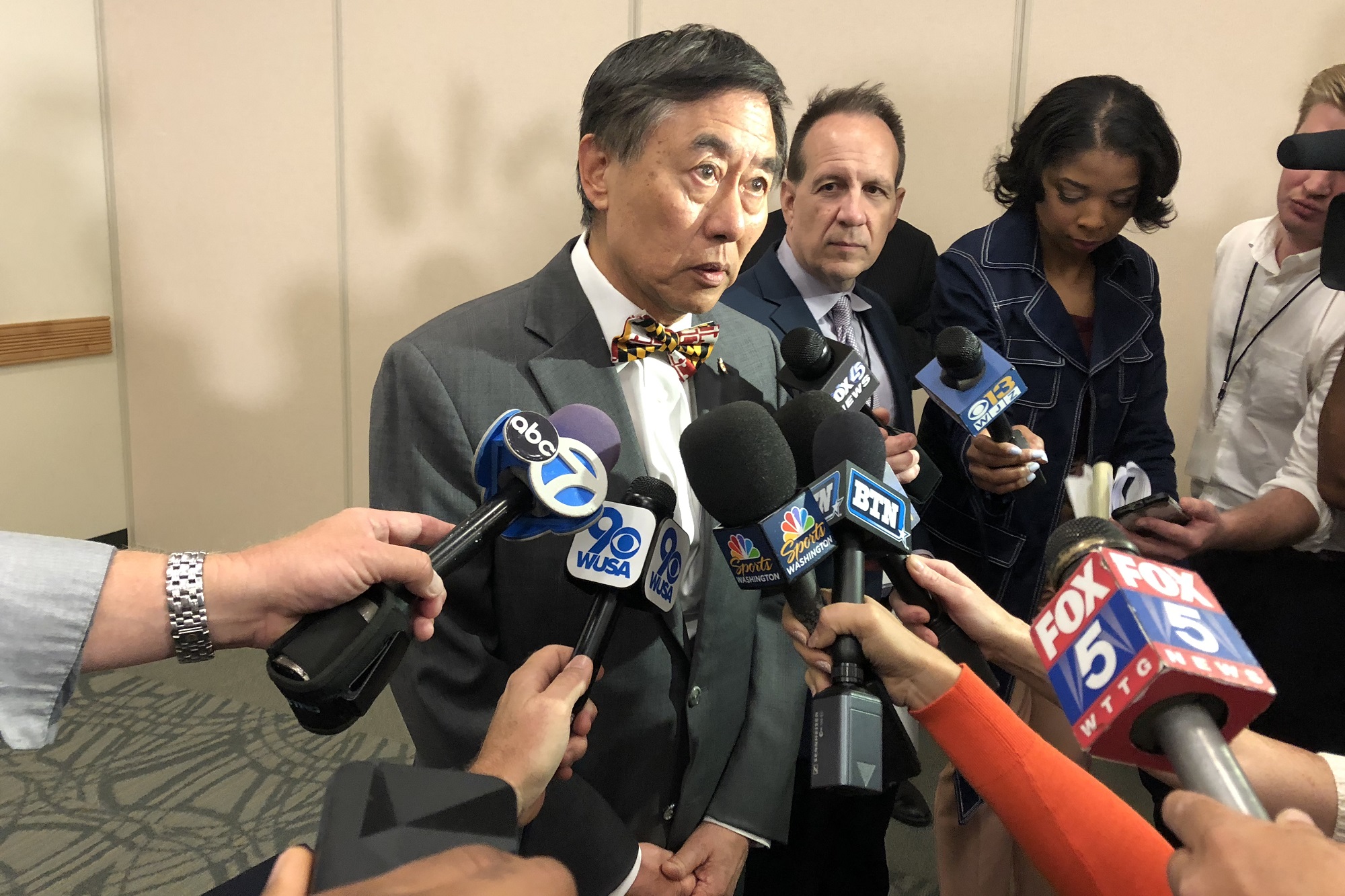By James Crabtree-Hannigan and Andy Kostka
Senior staff writers
Shortly after the release of a 126-page report about the death of football player Jordan McNair and the athletic department’s sports medicine policies, President Wallace Loh vigorously defended the University of Maryland’s current organizational model of athletic training and emphasized the changes the school has already made.
“Even though the recommendations are coming in now, there were a whole bunch of things that we started doing since early July,” Loh told reporters in Towson University’s West Village Commons on Friday evening. “A lot that [Walters] mentioned, we’ve already done.”
The university said it will implement all 27 recommendations published in the report by Rod Walters, the sports medicine consultant it hired in June to conduct an independent investigation. Earlier Friday, Walters presented the report to the University System of Maryland Board of Regents, which sets policy for its 12 member institutions.
[Read more: “A deep loss”: Following the death of Maryland football’s Jordan McNair]
As the university has done for months, Loh stressed that the school was proactive in hiring Walters the day McNair died, which was at the end of a two-week hospital stay following heatstroke he suffered at a team workout.
On Aug. 10, ESPN published two reports that made McNair’s death national news, alleging that the team’s staff had failed to recognize McNair’s obvious symptoms of duress, and that coach DJ Durkin had fostered a culture of abuse within the program.
Following ESPN’s reports, athletic director Damon Evans placed Durkin on leave, along with strength and conditioning coach Rick Court and two high-level trainers, Wes Robinson and Steve Nordwall. Court quickly resigned.
At a press conference Aug. 14, Loh said the university accepted “legal and moral” responsibility for McNair’s death based on Walters’ preliminary findings.
[Read more: UMD AD Damon Evans says there’s no “no athletic video” of Jordan McNair’s final workout]
The university has attempted to maintain a clear divide between McNair’s medical care and the reports of a toxic team culture, but Loh and Evans said Friday that they won’t be making any personnel decisions — on trainers or coaches — until the conclusion of the investigation into the team’s culture. Board of Regents President James Brady said that investigation is expected to conclude “soon,” although it doesn’t have an announced end date.
“This is the procedure for all personnel,” Loh said. “If there is an investigation, they’re always placed on administrative leave until the investigation is completed. And as the board chair said, we shall address that issue together with the larger issue of the culture.”
In 2017, Loh shot down a proposal from then-athletic director Kevin Anderson that would have shifted the department’s athletic training model to a fully independent one that would more closely align with NCAA guidelines. But Loh said Friday that Maryland’s coaches do not have any control over medical personnel.
“What protects the students is not who pays the paycheck of the athletic director or whether we should outsource it through the University of Maryland, Baltimore,” Loh said. “That’s not the key issue. … It is who are the personnel [overseeing athletic trainers], and the final word is always the physician. It is not the coaches; it is not the athletic department.”
In the report, Walters said Maryland’s current model is “very prevalent” in college sports and that it “meets the recommendation for removing conflict of interest.”
When asked how the school can be sure coaches don’t pressure medical decisions, Loh said that’s because they are not allowed to do so.
“Can a coach try to persuade? I suppose so,” Loh said. “But that coach would be out of line.”
When asked why the system failed McNair, Evans said “that is what we are looking into.”
Loh said Walters was frequently in College Park over the summer to make recommendations. The university implemented some of those changes in July, Loh said, including using the wet bulb globe temperature to gauge weather conditions, having mandatory hydration testing before workouts, offering more frequent and longer recovery periods and having more physicians and athletic trainers at practices and games.
Walters also began training athletic staff members in the emergency action plan as well as overhauling the evaluation and treatment protocol, which needs to be approved by the Maryland Board of Physicians.
“In effect, every athletic trainer is directly supervised by a licensed physician,” Loh said.
While Loh and Evans highlighted the changes already made to Maryland’s athletic training protocols, Loh said the university has yet to add an independent sports medicine group to review Maryland’s implementation of the promised changes “once or twice” a year.
“What I want are recommendations to make sure that this tragedy never happens again,” Loh said.
This article has been updated.



